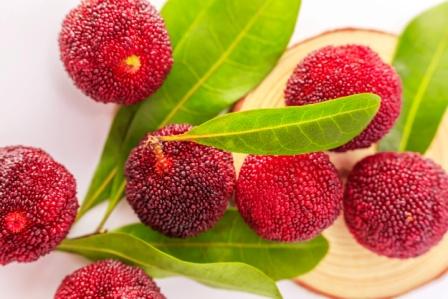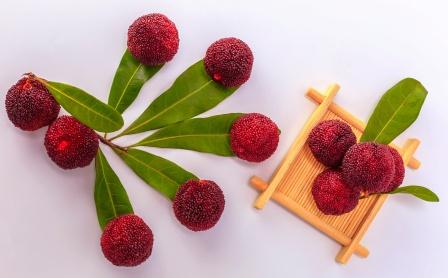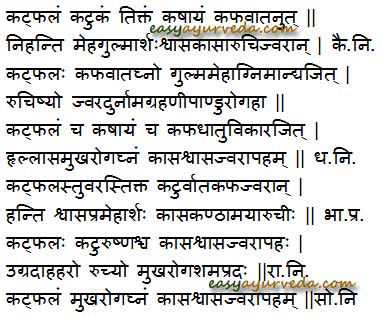Box Myrtle (Katphala) Uses, Research, Remedies, Side Effects
Katphala- Myrica nagi is an Ayurvedic herb, used for the treatment of swelling, intestinal worm, paralysis, joint pain, oral ulcer, diabetes and diarrhea. It is also called Box Myrtle.
Latin name- Myrica nagi thumb, Myrica esculenta Buch-Ham.
Family- Myricaceae (Katphala kula)

Table of Contents
Vernacular names
Names in different languages:
Hindi name- Kayaphal
English name- Box myrtle, Bayberry, Sweet gale, Candle berry, Kaphal,
Arabic name- Azuri, Kandool
Bengali name- Kayachal
Gujarati name- Kayaphal
Kannada name- Kirishivani
Malayalam name- Maruth
Marathi name- Kayaphal
Tamil name- Marudam
Telugu name- Kaidarayamu

Morphology
Morphology of Myrica nagi:
Katphala is an evergreen medium sized tree growing to a height of 5- 15 m and found in the Northern Himalayan belt of India. The bark of the tree is thick, cracked and pale brown colored. The branches are covered with small hair-like structures. The leaves are about 3-6 inches long, round to oval in shape and have vein-like structures. The flowers are small, red in color and found in clusters. Fruits are small, round in shape, reddish colored when ripe having sweet and sour taste. Flowers are seen in winter and fruits during summer.
Properties, part used, dosage
Box Myrtle medicinal properties:
Rasa (Taste) – Kashaya (Astringent), Tikta (Bitter), Katu (Pungent)
Guna (Qualities) – Laghu (Light for digestion), Teekshna (Pungent in nature)
Vipaka – Katu (Undergoes Pungent taste after digestion)
Veerya (Potency) – Ushna (Hot)
Karma (Actions) – Kaphavata shamaka (reduces vitiated kapha and vata dosha)
Pharmacological action – Antiseptic, Antipyretic, Hypotensive, Antispasmodic
Part used- Bark, Fruit
Dosage-
Bark powder- 3 to 5 g
Fruit juice- 10 to 25 ml
Various species
Myrica esculenta
Myrica crucifera
Myrica cordifolia
Chemical constituents
Myrica nagi chemical composition:
The stem bark gave myricanol, aproanthocyanidin. The root bark yielded beta-sitosterol, taraxerol and myricadiol.
Uses
Medicinal Uses of katphala:
- Fresh fruit juice of katphala is added with sugar candy and water and consumed as a thirst quencher in the summer season.
- The powder of the dried bark of Myrica nagi is sprinkled over fresh wounds to control bleeding and healing of wounds.
- The bark of the tree is processed in sesame oil and thus the oil prepared is applied externally in conditions of facial paralysis, paralysis, joint pain to benefit the patient.
- Decoction of the bark of the katphala tree is used for gargling to treat gingivitis and oral ulcer.
- The dried powder of bark of katphala is used as tooth powder to treat gingivitis.
- Paste from the bark of Myrica negi is applied locally to treat skin diseases.
- Decoction from the bark of trees is given in a dose of 30-40 ml to treat intestinal worms and control diabetes.
- The powder of the bark of katphala in a dose of 3-5 g is mixed with a glass of buttermilk and consumed to treat diarrhea and indigestion.
- 3-5 g dried powder of the bark is mixed with honey or sugar candy and given in conditions of cough, rhinitis and asthma for treatment.
Sanskrit verse

Indications
Indications as per traditional Ayurveda:
Meha – diabetes, urinary tract disorders
Gulma – Tumors of the abdomen,
Arsha – hemorrhoid’s
Shwasa – asthma and chronic respiratory disorders
Kasa – cough, cold
Aruchi – anorexia
Jwara – fever
Agnimandya – low digestion strength
Grahani – IBS, sprue, altering diarrhea and constipation
Pandu – anemia
Hrullasa – nausea
Mukharoga – oral disorders
Daha – burning sensation, as in gastritis, neuropathy, burning sensation in eyes etc
Rochishnu – improves taste, appetite
Katphala nasya – Su.u. 26/22.
Fine powder of katphala twak (Myrica nagi Thumb) should be blown into the nostril through a pipe 6” long. Katphala nasya is indicated for kaphaja Shirorogas.
Adverse effect
No adverse effect is known or reported after the normal use of katphala.
Interaction with medicines, supplements
Can this be used while taking Homeopathic medicine?
Yes. This product does not react with homeopathic medicine.
Can this medicine be continued while taking supplements like multivitamin tablets, Omega 3 fatty acids etc?
Yes. Generally, this product goes well with most dietary supplements. However, if you are taking more than one product per day, please consult your doctor for an opinion.
With western
medicines
Seek your
doctor’s advice if you are taking this product along with other western
(allopathic / modern) medicines. Some Ayurvedic herbs can interact with modern
medicine.
If both Ayurvedic and allopathic medicines are advised together, then it is
best to take Allopathic medicine first, wait for 30 minutes and then take the
Ayurvedic medicine.
Ayurvedic medicines
Ayurvedic medicines containing Katphala:
Pushyanuga choorna: This is a powder used in the treatment of gynecological disorders like dysmenorrhea, Leucorrhoea, Menstrual disorder, Excessive menstrual bleeding of various etiology. It is also used in treating uterine infections and Hemorrhoids.
Guggulwasava: Gulgulwasavam is a liquid Ayurvedic medicine used in the treatment of diseases pertaining to liver and spleen.
Arimedadi taila: It is an Ayurvedic oil used for a famous procedure called oil-pulling or gargling. It helps to improve the strength of teeth and sense organs.
Khadiradi vati: It is a tablet, used in Ayurvedic treatment of bad breath, oral ulcers, teeth diseases etc. It is advised to keep this tablet in mouth and swallow its pieces slowly.
Maha kukkutamamsa taila: It is an Ayurvedic oil, used for both oral administration and external application. It is useful in the treatment of rheumatism and muscle atrophy.
Devadarvyadi kashaya: It is an Ayurvedic medicine in decoction form. It is used in the treatment of cough, cold, bronchitis, asthma, bodyache etc.
Katphaladi churna: It is an Ayurvedic medicine in herbal powder form. It is used in the treatment of fever, throat infection, cough, asthma, etc.
Nograin capsule: It is a proprietary Ayurvedic medicine, used in the treatment of headache, anxiety, depression, lack of sleep, burning sensation, eye irritation, sensitivity to light, anger, hyper-irritability, nose bleeding.
Anjal tablet: It is a proprietary Ayurvedic medicine, used in the treatment of headache, cold, flue, fever, body ache, cough, muscular pain.
Research
Research articles related to Myrica nagi:
Anti- inflammatory action: The present study evaluated the anti- inflammatory activity of ethyl acetate and aqueous extracts of bark of M. nagi using carrageenan and histamine induced rat paw edema. These ethyl acetate and aqueous extract extracts also showed % inhibition of edema 25% and 18% respectively than the standard drug (27%) when rats were challenged with histamine induced rat paw edema.
Anti- oxidant activity: The present communication deals with the antioxidant activity of the polar, no- polar and methanolic extracts of Myrica nagi bark powder.Phenolic and Flavonoid content was observed highest in the polar extract of M. nagi and least in the non- polar extract of M. nagi. 1,1-diphenyl-2-picryl hydrazyl (DPPH) radical scavenging effect of the extracts was determined spectrophotometrically. The highest radical scavenging was observed in the polar extract of M. nagi with IC50= 296.53μg/ml. All these findings reveal the antioxidant activity of polar extract of M. nagibark may be because of the presence of a high amount of flavonoids and phenolic constituents.
Anxiolytic property: In the present work, the anxiolytic and antidepressant effects of an ethanol extract of M. nagi were analyzed at three different dosages (100, 200, and 400 mg/kg, p.o.) by elevated plus-maze, light/dark exploration test, tail suspension test, and the forced swimming model. Oral administration of the ethanol extract (100, 200, and 400 mg/kg, p.o.) of M. nagi showed significant (p < 0.01) and dose-dependent anxiolytic activity by increasing time spent in the open arms of the elevated plus-maze and in the lit box indicating an anxiolytic effect.
Classical categorization
Charaka samhita –
Vedanasthapana – pain relieving group of herbs
Shukra Sodhana – semen cleansing group of herbs
Sandhaniya – wound and fracture healing group of herbs
Sushruta samhita- Lodhradi, Surasadi
Astanga samgraha- Surasadi
Bhavaprakasha- Hareetakyadi varga
Dhanvantai Nighantu- Guduchaydi varga
Kaiyydeva Nighantu- Oushadhi varga
Raja Nighantu- Prabadradi varga
Shodala Nighantu- Guduchyadi varga
Scientific classification
Kingdom: Plantae
Order: Fagales
Family: Myricaceae
Genus: Myrica L
Sanskrit Synonyms
Mahavalkala- Tree has thick bark
Soma Valka, Soma Padapa – It has whitish bark
Kaidarya – It has bitter taste
Sriparni, Kumuda, Kumbha, Mahakumba, Rohini,
Kumuda, Bhadra, Bhadravati, Truti, Kaitarya
Mahakaccha, Mahakumbha, Kumbheeka, Kandula, Prachetasi, Rama senaka,
Author:
Dr.B.K.Prashanth M.D (Ayu), Ph.D
E mail: [email protected]
Click to consult Dr Prashanth BK
Sthanika Karma (Systemic Action)
External – Bark is one of the strong sirovirechana herb (Helps to expel out vitiated doshas from the scalp and upper part of chest region). Antipruritic, Anti inflammatory, helps to constrict the uterine muscles.
Nasal installation (Nasya) with this herb is indicated in Rhinitis, Unconsciousness, headache etc.
Antimicrobial and Styptic in nature, powder can be sprinkled on wounds to facilitate fast healing.
Oil is indicated in Hemiplegia, Facial palsy, etc.
Indicated in stomatitis and in toothache for gargling.
Powder and paste can be used for skin diseases
Powder can be tied into a cloth and applied to the vaginal area to facilitate uterine contraction
Nervous system – Pacifies vata dosha, Indicated in Hemiplegia, facial palsy etc.
Digestive System – Carminative, absorbent Indicated in loss of appetite, abdominal cramp, Diarrhea
Circulatory System – Sandhaniya (Facilitate healing process) Indicated in generalized edema, epistaxis etc.
Respiratory system – Helps to eliminate excess kapha dosha from the respiratory tract. indicated in Asthma, Rhinitis, cough etc.
Reproductive system – indicated in impotency
Excretory system – decreases urine output, indicated in diabetes
Skin – indicated itching and associated skin disorders.










